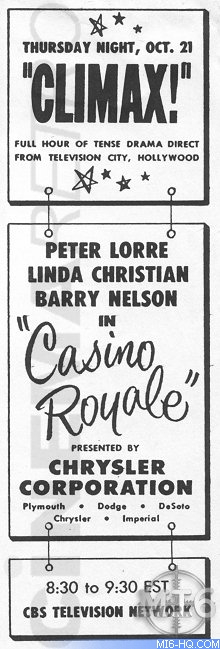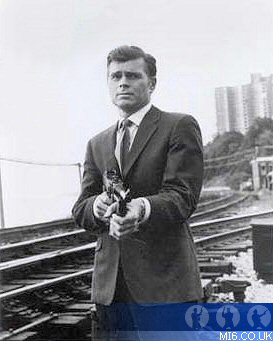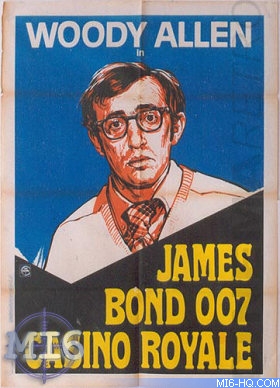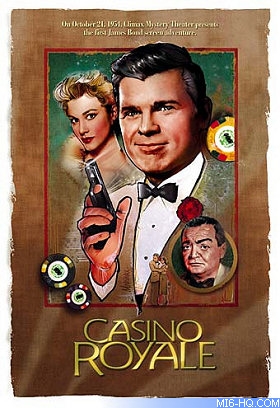|
|
|
 |
| |
50 years on, Lee Pfeiffer commemorates 007`s
screen debut and shares some of actor Barry Nelson’s
memories of being the first James Bond...
|
|
The Curious Legacy of Casino Royale
22nd October 2004
Fifty years ago this month, the first screen adaptation of
an Ian Fleming James Bond novel was presented to audiences. Lee
Pfeiffer, co-author of the best-selling book “The Essential
James Bond” and Editor-in-Chief of the new
film magazine “Cinema Retro” commemorates 007’s
screen debut and shares some of actor Barry Nelson’s memories
of being the first actor cast as James Bond.
When most movie fans are asked to name the
first actor to portray James Bond, the answer is inevitably
“Sean Connery”. However, eight years prior to
Connery donning Mr. Bond’s shoulder holster for the
first time in “Dr. No”, American actor Barry
Nelson brought James Bond to life in a one hour live television
production of “Casino Royale”. The year was
1954 and Bond’s literary father Ian Fleming had nervously
overseen the release of his first novel “Casino
Royale” in England. Although Fleming was well
regarded as a journalist, he had no prior experience as
a novelist. In the upper-crust world of the Park Lane crowd
with whom Fleming associated, there was an air of tawdriness
regarding writers who penned “potboiler” thrillers.
The novel, published by Jonathan Cape, caused a bit of a
stir because of its generous doses of sex and violence.
The controversy helped the book gain publicity and the resulting
sales made for a modest success.
Fleming was always convinced that the Bond novels would
make a viable franchise for the screen. He recognized that
the post WWII period in England was one of hardship and
despair. The British may have been on the winning side,
but the economy was dismal, good jobs were lacking and shortages
of everyday goods were a common occurrence. He intuitively
felt that the general public would respond to a hero who
acted as though the British empire was still in fine form. |
|

Above: 1st edition Jonathan Cape hardback
(UK) |
James Bond was the ultimate anti-hero: a man who had only a
grudging respect for authority, an obsession with high stakes
gambling and exotic travel, and an even more fervent passion for
the seemingly endless array of sexually aggressive women who surrounded
him. These qualities may have endeared the character to the British
public, but prospective film producers were intimidated by them.
Fleming found a conspicuous lack of interest in Hollywood in terms
of seeing potential for a James Bond film. The novel’s emphasis
on sex and violence alienated investors during a period in which
prudish studio executives felt compelled to water down even James
Jones’ steamy bestseller “From Here to Eternity”
before bringing it to the screen.

|
|
Fleming ultimately conceded to an unrewarding deal whereby
he would sell the screen rights to the novel for a paltry
$1,000 on the proviso that the American t.v. network CBS
would broadcast a one -hour production of “Casino
Royale”. Making the best of a bad hand, Fleming rationalized
that any exposure for the character was better than none.
During the mid-1950’s, there were a number of shows
that presented one hour live t.v. dramas. Among the more
popular was “Climax!”, a program hosted by actor
William Lundigan. Each week a new cast was employed to bring
a different story to life. CBS adapted “Casino Royale”
to the one-hour slot, and in doing so, quite obviously left
most of the nuances and rich characterizations from the
source novel out of the teleplay. In the CBS version, telecast
in October, 1954, Bond was reduced to a Bogart-like gumshoe
with only the slightest connections to national intelligence
operations. The character was presented with the implication
that he was a free-lance adventurer who, in the style of
Simon Templar, uses his considerable courage and self-defence
skills to thwart the forces of evil. Even Fleming must have
cringed when, at one point, another character refers to
his literary creation as “Card Sense Jimmy Bond”.
Since the character of Bond was virtually unknown, the producers
also felt free to Americanize him. Barry Nelson, a popular
t.v. and screen star, was cast in the role.
Nelson, a stolid all-American who sported a crew cut, was
a far cry from the actors Ian Fleming had envisioned for
the role of Bond. In fact, Fleming had hoped that both Noel
Coward and David Niven could be tempted to portray Bond
onscreen. Nelson was unaware of the fact that the character
of Bond was an Englishman. In an exclusive interview with
Cinema Retro, he said “At that time, no one had ever
heard of James Bond….I was scratching my head wondering
how to play it. I hadn’t read the book or anything
like that because it wasn’t well known. The worst
part of it was that I learned it was to be done live. I
thought I was finished with live t.v. I was trying to get
out of it, actually.”
Left: Original T.V Guide advertisement
promoting the screen debut of James Bond on "Climax!"
(Photo: Lee Pfeiffer/ Cinema Retro archive). |
Nelson’s reluctance to do the show
was due to the fact that he had already been a veteran of
several series that had been broadcast live. Although these
increased his popularity with audiences, the pressure of
performing live left no safety net. He recalled of “Casino
Royale”, “They were making changes up to the
last minute. There was nothing you could do if anything
went wrong.” The casting of Linda Christian, with
whom he worked at MGM, as the femme fatale of the teleplay,
Vesper Lind, buoyed Nelson’s spirits.
Additionally, legendary screen bad guy Peter Lorre had
been cast as the villain Le Chiffre. Nelson enjoyed acting
opposite these two talented individuals, but was frustrated
by the fact that time constraints had eliminated any background
information about the character of Bond. Nelson recalled
“I was very conscious of the fact that there wasn’t
much to go on. It was too superficial.”
|
|

Above: Barry Nelson |
Despite a virtually non-existent budget, the show did succeed
in capturing some of the tension of the “do or die”
gambling bout between Bond and Le Chiffre. Additionally, Peter
Lorre was a fairly inspired choice for the role of the first Bond
villain. The production was directed William H. Brown, whose resume
was uniquely undistinguished. More impressive were the credentials
of the screenwriter Charles Bennett, who had collaborated with
Alfred Hitchcock on several of the Master’s early films,
as well as having written the screenplays for such high profile
films as “Reap the Wild Wind”. He would go on to write
episodes of such popular 1960’s series as “Land of
the Giants” and “The Wild, Wild West”.
“Casino Royale” made little impact on audiences or
critics and was largely dismissed as just another “run of
the mill” edition of “Climax!”. Over the next
few years, however, Fleming’s Bond novels began to grow
in popularity and by the early 1960’s they had established
an enthusiastic following throughout the world. He would later
regret having sold the screen rights to “Casino Royale”
for such a paltry sum. Fleming eventually contracted with producers
Albert R. Broccoli and Harry Saltzman to adapt his Bond novels
for the big screen, though Fleming himself would not be providing
the screenplays. His attempts to write scripts were notable only
in his failure to convey the type of action and drama that he
had mastered in his novels. A brief flirtation with bringing Bond
to the screen in the late 1950’s via a collaboration with
Kevin McClory and Jack Whittingham had yielded only frustration
and eventual legal troubles. Fleming wrote outlines for several
prospective Bond screenplays, but in contrast to his novels, these
were stodgy and bland attempts that did little to elicit excitement.
Under Broccoli and Saltzman, professional screenwriters succeeded
in creating a persona for Bond that eventually eclipsed that of
the literary 007 in terms of public recognition.

Above: A bizarre Italian poster promoting
Woody Allen in the equally bizarre 1967 film version of "Casino
Royale" (Photo: Lee Pfeiffer/ Cinema
Retro archive) |
|
The first Broccoli/Saltzman Bond film, “Dr.
No” premiered to record breaking grosses in 1962 and
a cultural phenomenon was born. By the mid-1960s’,
the screen rights to “Casino Royale”, which
had at one point been controlled by the producer Gregory
Ratoff, were now being handled by another producer, the
flamboyant Charles K. Feldman. With Bondmania sweeping the
globe, Feldman knew he had a hot property, as “Casino
Royale” was the only Bond novel that Broccoli and
Saltzman did not own the screen rights to. Feldman initially
proposed producing a film version starring Sean Connery,
in partnership with Broccoli and Saltzman.
When his offer was rejected, Feldman took an unorthodox
route. Inspired by the recent success of his zany comedy
“What’s New Pussycat?”, he decided to
turn “Casino Royale” into a big budget slapstick
comedy. He signed an eclectic and talented cast that included
Peter Sellers, Ursula Andress, Woody Allen and William Holden.
Ian Fleming’s wish to have David Niven play James
Bond was also fulfilled, though the author probably spun
in his grave if he saw the manner in which his literary
creation was interpreted. |
The big screen version of “Casino Royale” quickly
became a debacle, with an out-of-control budget skyrocketing as
multiple directors shot the film simultaneously at several British
studios. The ensuing mess was released in the summer of 1967 opposite
the “official” Bond film “You Only Live Twice”.
Although Feldman succeeded in garnering decent reviews for his
“hip” comedy, the sizable box-office grosses were
compromised by the film’s extravagant production costs.
The bizarre legacy of “Casino Royale” took another
turn in the 1980’s when film fan Jim Schoenberger visited
a local flea market. He noticed a pile of unlabeled 16mm films
laying in the rain and quickly made a deal to salvage them from
the owner at small cost. Upon returning home, he was shocked to
find that among the reels of film was a complete, uncut print
of the “Climax!” production of “Casino Royale”.
Schoenberger recognized the value of his find and eventually donated
the print to the care of the Museum of Television and Radio in
New York City (several years ago, Barry Nelson hosted a screening
of the program at the museum). In the early 1990’s, the
American cable station TBS presented a one-off showing of the
“Climax!” production introduced by noted film historian
Leonard Maltin. When it was discovered that Maltin had presided
over a notoriously incomplete showing of the film, he voiced his
displeasure. It seems that another print of the show had surfaced
and it was mysteriously missing the last few crucial seconds in
which Bond has to finally dispose of Le Chiffre by shooting him
once again. In the cut version, the villain is presumably dispatched
with one shot and the show ends far too abruptly. Sadly, this
is also the version that has been produced on most home video
versions, although Spy Guise had made the uncut version available
on VHS some years ago. In 2003, MGM released the big screen version
of “Casino Royale” on DVD in the United States. The
disc contained an interesting chat with the film’s last
surviving director, Val Guest. As an added bonus, the 1954 “Climax!”
show was included - although much to the frustration of fans -
the studio made the mistake of using a print of the truncated
version of the program.
Fifty years after the original telecast
of the first James Bond screen adventure, it’s worth
pausing to reflect on how this modest production paved the
way for the screen legacy of agent 007. Sometimes Bond’s
impact on popular culture manifests itself in unorthodox
ways.
Barry Nelson recalls a recent experience in which he and
his wife Nancy attended a small theater production that
required them to take a brief elevator ride to where the
play was being performed. Two young men and a woman entered
the elevator with them, causing the confined space to become
very crowded. Nelson recalls, “After a short lift,
everything stopped and we were between floors. Nothing was
open and there was nowhere for any air to get in. It got
very hot…..Everyone started to get a little panicky
and someone said “I wish James Bond were here!”
I thought to myself, “If only he knew that he is!”
Right: Commemorative lithograph by Spy
Guise Inc. Art by Jeff Marshall. Copyright www.spyguise.com |
|
 |
Cinema Retro Magazine
A more in-depth interview with Barry Nelson will be published
in a forthcoming issue of Cinema Retro magazine. Nelson will expand
upon his comments regarding playing James Bond, as well as discuss
working with legends such as Dean Martin and Stanley Kubrick.
For information about subscribing to the magazine, visit www.cinemaretro.com
Related Articles
 Casino Royale (1954) Coverage
Casino Royale (1954) Coverage
|
|
|